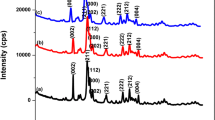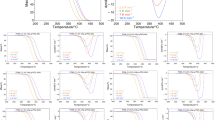Abstract
In the present study, aiming to control the setting reaction and to increase the strength of hydroxyapatite-based biocements, gelatin, citric acid and malonic acid, and combinations of them, were used as binders. The mechanical strength of the developed biocements was evaluated after 1 to 15 days of exposure (aging) to air with 100% relative humidity at 37–40 ºC. Especially for the case of gelatin, the mechanical properties of the biocements increased as a function of aging time in the humid environment. In this case, the standard compressive strength increased from ~19 to ~40 MPa, while the diametral compressive strength increased from ~2 to ~12 MPa, between day 1 and day 15 of aging. These values are similar to those reported in the past for HAp-containing biocements added with a variety of organic or inorganic binders. However, the resulting setting times were too long. Thus, it was proposed that crosslinking of gelatin by a suitable chemical agent during the application of the prepared HAp-based biocements could be a potential way to control their handling and setting characteristics, while preserving their good mechanical properties, good biocompatibility, and good solubilization characteristics in the presence of biological fluids.
Similar content being viewed by others
References
J. López-Cuevas, J.C. Rendón-Angeles, J.L. Rodríguez-Galicia and C.A. Gutiérrez-Chavarría, MRS Advances 2, 3851–3857 (2017).
M.P. Ginebra, M.G. Boltong, E. Fernandez, J.A. Planell and F.C.M. Driessens, in Transactions of the 21st. Annual Meeting of the Society for Biomaterials in Conjunction with the 27th International biomaterials symposium, (San Francisco, California, USA, 1995) p. 99.
Sergey V. Dorozhkin, J. Funct. Biomater. 4, 209–311 (2013).
R. O’Neill, H.O. McCarthy, E.B. Montufar, M.-P. Ginebra, D.I. Wilson, A. Lennon, N. Dunne, Acta Biomater. 50, 1–19 (2017).
M. Nagose and R. Chen, J. Oral Maxillo. Surg. 149, 1305–1309 (1995).
W.E. Brown and L.C. Chow, in Cements Research Progress, edited by P.W. Brown (American Ceramic Society, Westerville, OH, USA, 1986) pp. 351–379.
M. Otsuka, Y. Matsuda, Y. Suwa and J.L. Fox, J. Biomed. Mater. Res. 29, 25–32 (1995).
A.A. Mirtchi and J. Lemaitre, Biomaterials 11, 83–88 (1990).
G. Vargas, J.L. Acevedo, J. López and J. Romero, Mater. Lett. 62, 3656–3658 (2008).
F.M. Fernandes, M. Darder, A.I. Ruiz, P. Aranda and E. Ruiz-Hitzky, in Nanocomposites with Biodegradable Polymers: Synthesis, Properties, and Future Perspectives, Serie Monographs on the Physics and Chemistry of Materials, edited by V. Mittal (Oxford University Press, UK, 2011) pp. 209–233.
Author information
Authors and Affiliations
Corresponding author
Rights and permissions
About this article
Cite this article
López-Cuevas, J., Vargas-Gutiérrez, G., Rodríguez-Galicia, J.L. et al. Effect of some organic binders on the mechanical strength of hydroxyapatite-based biocements. MRS Advances 3, 3729–3734 (2018). https://doi.org/10.1557/adv.2018.592
Published:
Issue Date:
DOI: https://doi.org/10.1557/adv.2018.592




